
Finding this moth was just a lucky break for me, as it didn’t come to UV lights, per se, though I was less than 50’ from my light in a little clearing on the bank of Canyon Creek in Clark County, Washington (for those who may have wondered why I sometimes say Canyon Creek is in Clark County, and sometimes say it is in Skamania County, it is because it flows through both counties, and most of my favorite sections are near the border between the two). What happened was that I saw it fluttering around in the beam of my headlamp as I had my head tipped back drinking a Mountain Dew, and without thinking I flung my hand toward it, and snatched it from the air! When I peeked between fingers into the palm of my hand I almost couldn’t believe that I had actually caught it, since I don’t exactly have Kung Fu type reflexes, and I knew this was something new for these profiles, although my first thought was that it was some sort of forester moth.

But as soon as I looked into the forester moths I realized it wasn’t one of them, because the ones in our region all have yellow along the thorax, a fact I’d forgotten since I’ve only ever found one. So I ran it through the Leps | Fieldguide app, which immediately gave me Desmia maculalis/funeralis. Then I went to BugGuide, which has 2 nice sections on differentiating the species, one at Desmia funeralis vs Desmia maculalis – BugGuide.Net, and another at funeralis or maculalis – BugGuide.Net.
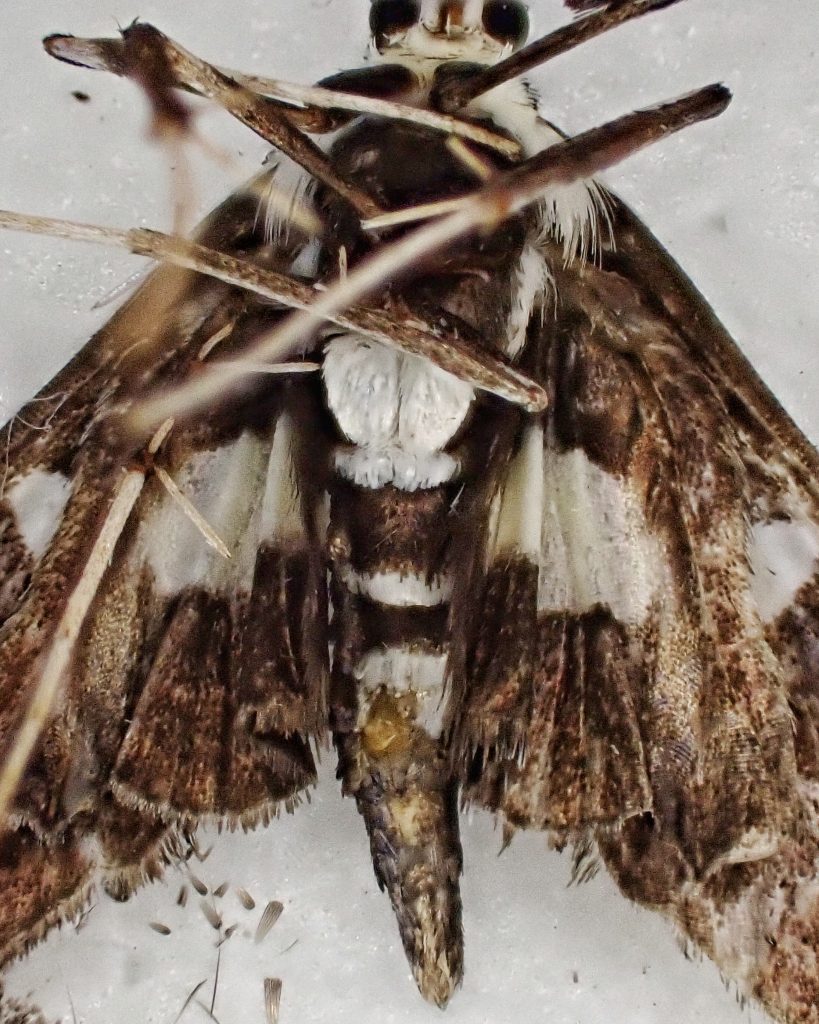
It was clear that I needed to get ventral shots of this moth to determine whether the underside of the abdomen was almost all white, or whether it was banded. However, as soon as I tipped this guy (males have a noticeable bend in their antennae) out of his container, he flew across the room. Fortunately he landed on a shirt I had flung over a chair, so I was able to get some dorsal shots. But it was obvious he wasn’t going to put up with being flipped on his back, so I popped him back into a container, and then into the fridge. Unfortunately, when I got him out of the fridge the next day with the idea that I’d put him in a clear container so I could photograph his undersides, he had expired. But that did make it easy to get diagnostic photos of his abdomen, and confirm that it was, as I suspected because the range of D. funeralis doesn’t come within 500 miles of where I found him, Desmia maculalis.
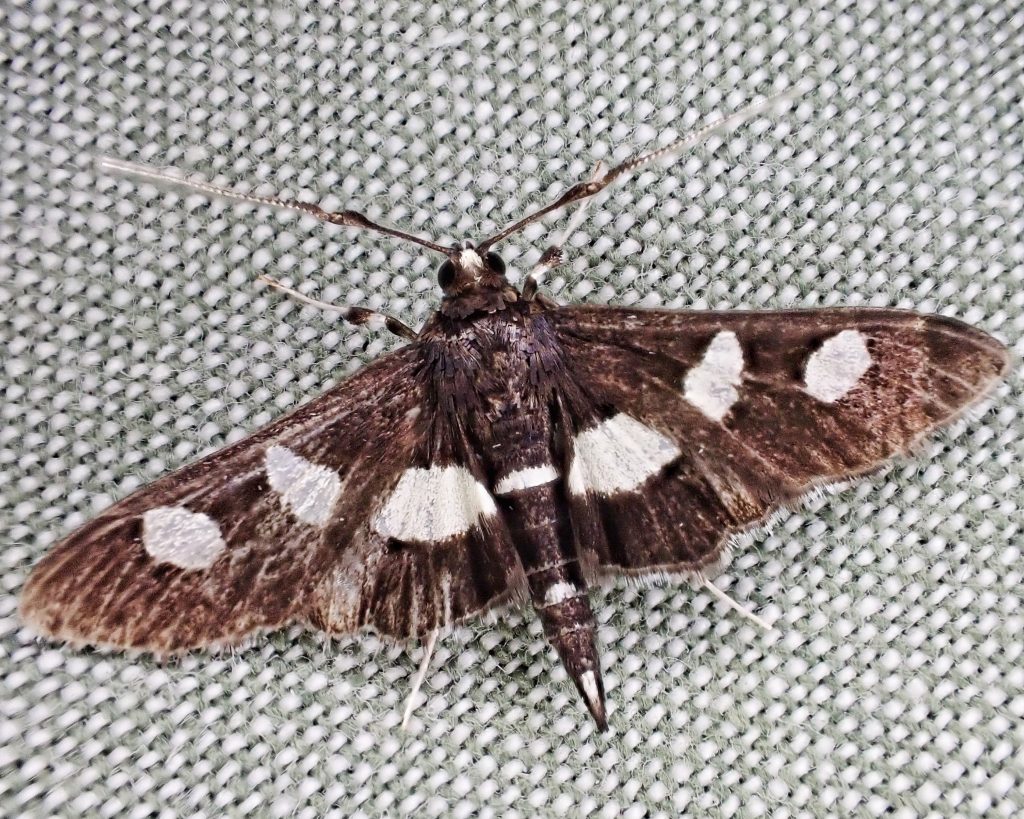
This originally appeared (though it turns out that they are quite common in some areas- see next paragraph) to be one of only a few records for this species in the PNW, but that may be because there is much confusion over the identity of Desmia moths in our region and in general, and D. maculalis and D. funeralis have been considered synonymous off and on for the last century. But the current thinking is that they are separate species. D. funeralis has been studied a fair amount due to its economic impact on grape growers, though it is hard to know whether any of that applies to D. maculalis, since they have often been lumped together. One thing does seem certain, and that is that “As soon as the larva is large enough it folds the leaf, exposing the under surface, the edge being held in place by bands of silk thread. It is within the protection of this fold that the larva feeds, skeletonizing the leaf on the upper surface.” JF Strauss (1916) https://naldc.nal.usda.gov/download/CAT87211708/pdf .
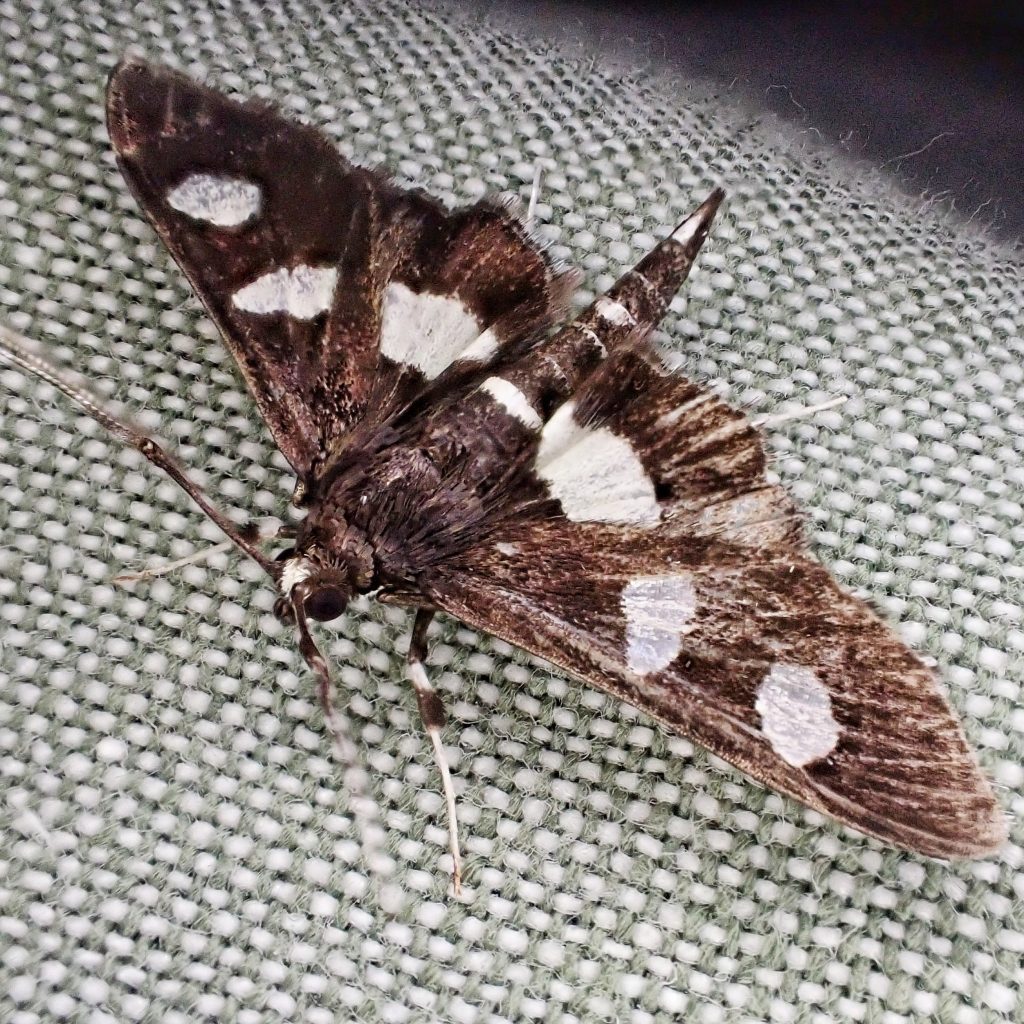
So, after I’d already written and scheduled this profile for publication, and thanks to a fortuitous posting of what I believe to be a photo of a Desmia maculalis found in Gales Creek, Oregon, and David James’ comment on that photo, I found out that Desmia maculalis has been found to be a pest in grape arbors around the Tri-Cities area. In the spring of 2018 David James of the Washington State University Irrigated Agriculture Research and Extension Center in Prosser (and co author with David Nunnalee of the excellent book “Life Histories of Cascadia Butterflies”; 2011) was informed that there were leaffolder caterpillars in some vineyards, and he identified the culprits as D. maculalis, rather than the suspected D. funeralis, which has been a known grape pest in California for many years. David studied the impact and life history of these moths in these vineyards for two + years, and kindly allowed me to incorporate some of his findings in this profile. For more on this outbreak see Unravelling the mysteries of the grapevine leaffolder – Good Fruit Grower. David James added some comments after reading this profile; “A couple of other interesting things about Desmia maculalis: It seems to be essential that the overwintering pupae (on the ground) are protected by the protective leaf envelope that the pupating larva engineers. Without it, pupae die. There is a pheromone available for the related species funeralis that maculalis sometimes responds to. However, the best attractant for adult maculalis is a fermenting mix of molasses in a bucket!”
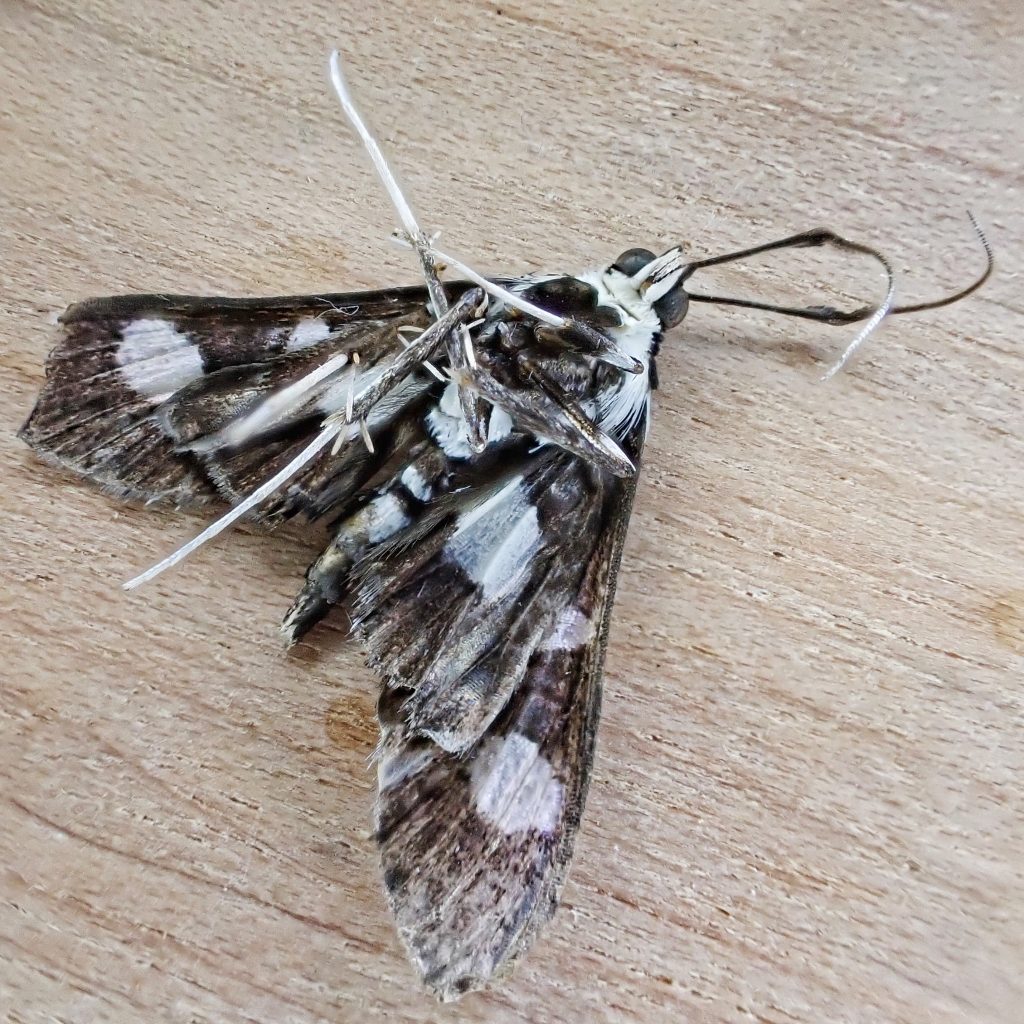
This member of the family Crambidae doesn’t seem to have an accepted common name, although one site calls it a white-headed grape leaffolder, to distinguish it from the grape leaffolder (Desmia funeralis). However “A significant white spot on the head is, according to the Covell Field Guide, a characteristic mark of Desmia maculalis. Brian Scholtens had previously informed Bob Patterson that this is not a reliable character and that two species (D. maculalis and D. funeralis) cannot be distinguished in typical dorsal view photos…” http://mothphotographersgroup.msstate.edu/species.php?hodges=5160
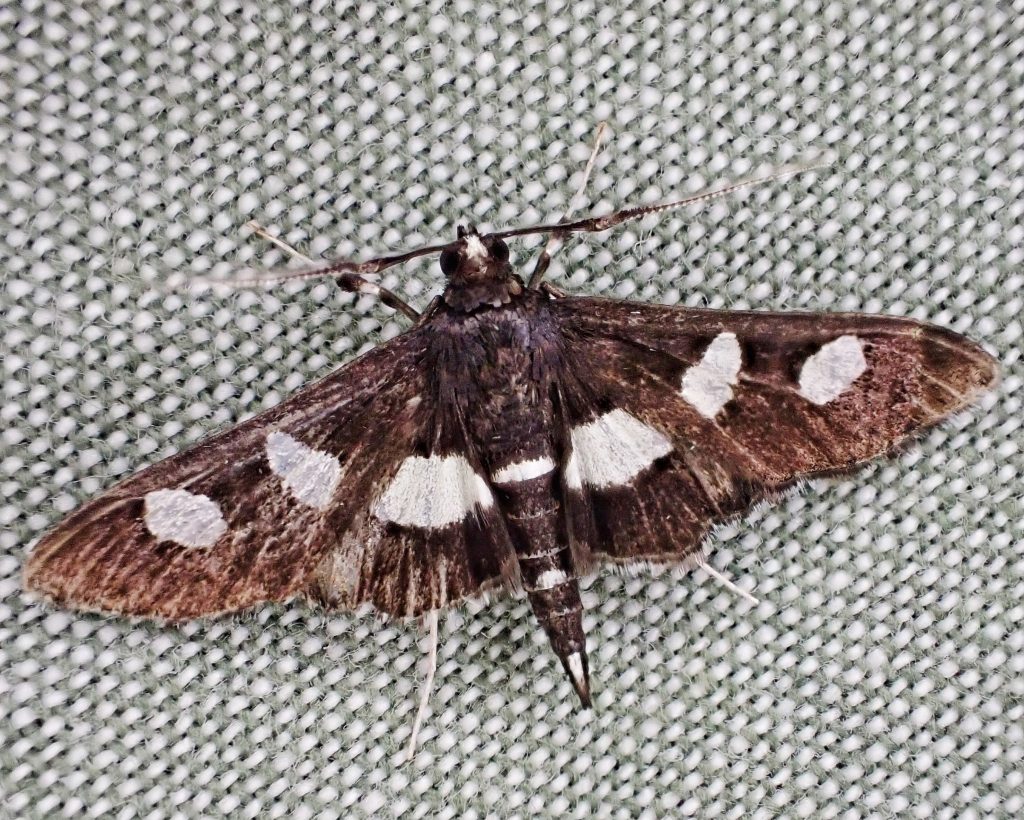
Description– Small (wingspan 18-24mm) moth with black fore-and hindwings that have 2 large white spots on the forewing and one white spot on the hindwing; ventral abdomen has bands of white with at least one black segment in between; dorsal abdomen has two thin white bands, and a white tip; dorsal thorax is all black, and the ventral thorax is white in front; dorsally the black head often has a white dot, and the ventral side is white; legs and antenna are black and white; males have a distinctive bend roughly in the middle of the antenna; females have hindwing spot at least partially, if not wholly, bisected.
Similar species– Desmia funeralis has a solid white ventral abdomen, and probably isn’t found in our region; forester moths (genera Alypia and Androloma) have light yellow on each side of the thorax.
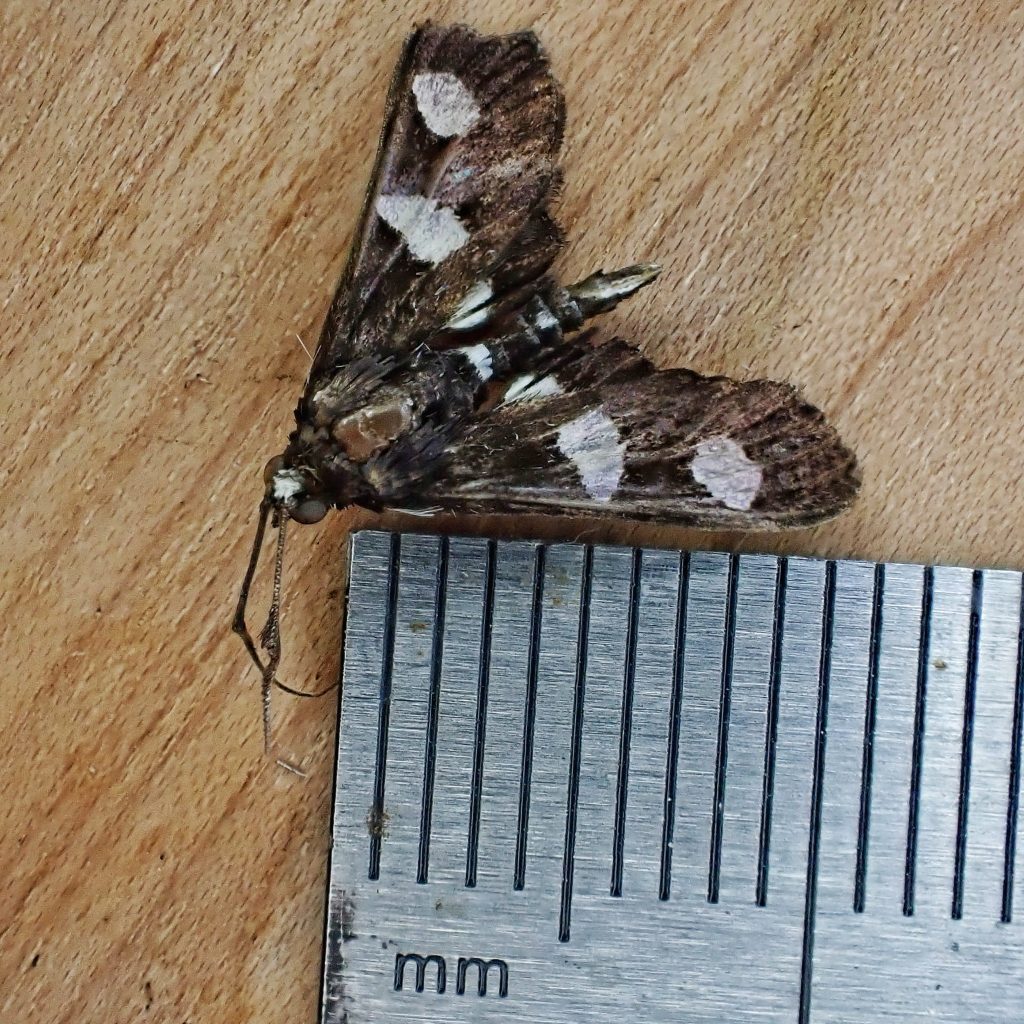
Habitat– I can find no information at all about habitat for this particular species, but on the comparison page for this species and D. funeralis it says the habitat is “deciduous forests and edges” funeralis or maculalis – BugGuide.Net ; presumably near their larval hosts, though no one seems sure what they are in this region; mine was found near a creek that flows through a second growth mixed forest of alder, maple, Douglas-fir, cedar, western hemlock etc. at about 709’ elevation.
Range-Primarily eastern North America and southwestern US; populations in the PNW are disjunct, and the only records I can find from our region, besides the one I just found (shown here on BugGuide Desmia maculalis – BugGuide.Net– click the data tab to see the location where it has been found), are from around Spokane, Washington, and Medford, Oregon.
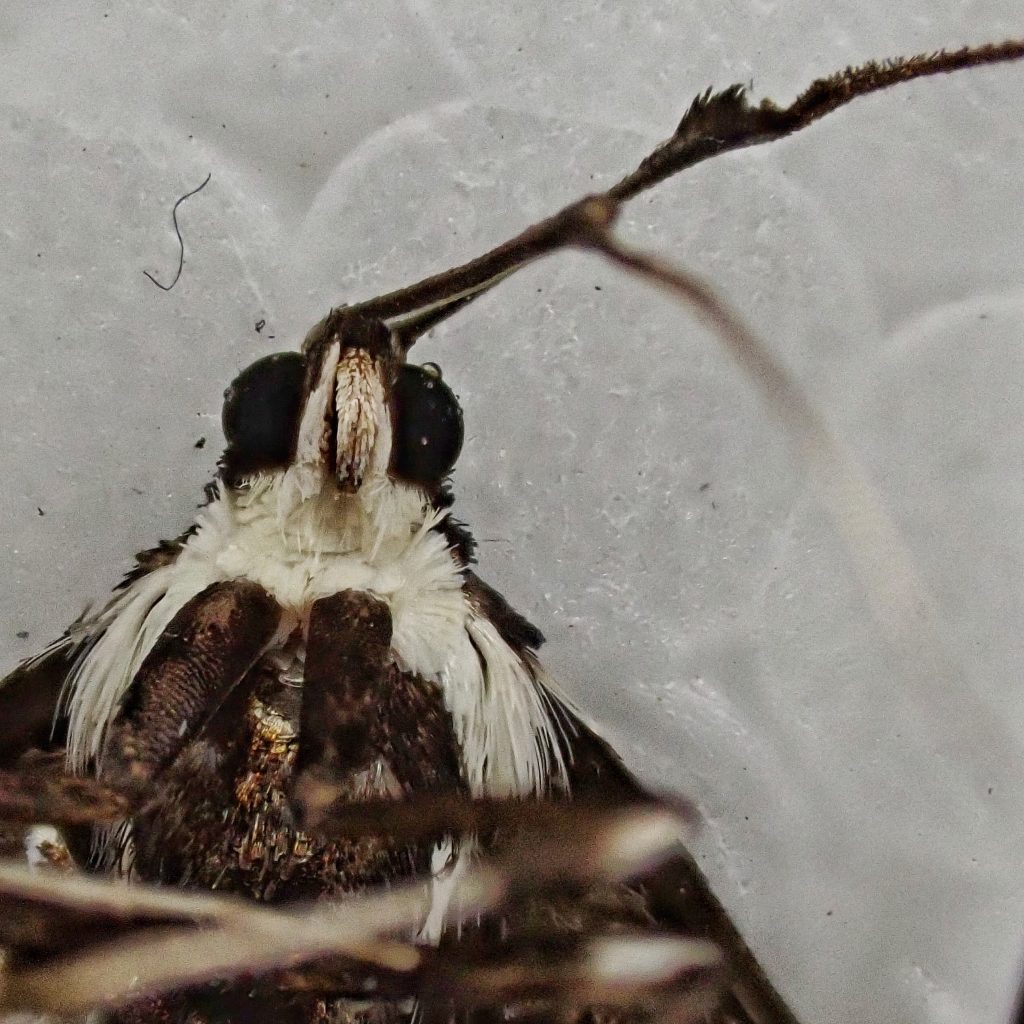
Eats– Recorded from “Seedbox (Ludwigia alternifolia) and Virginia Creeper (Parthenocissus quinquefolia). Presumably other members of Onagraceae and Vitaceae are utilized as well.” SpeciesDesmia maculalis – Grape Leafroller – Hodges#5160 – BugGuide.Net; however, L. alternifolia and P. quinquefolia are eastern North American species, and are not found in our region, though we do have Ludwigia palustris (a native) and Parthenocissus vitae (introduced), as well as other Onagraceae and Vitaceae; are now known to use cultivated grapes as a larval host in Washington state.
Eaten by-Presumably by insectivores of all classes, especially spiders, lacewing larvae, and true bugs in the families Anthocoridae (minute pirate bugs) and Geocoridae (big-eyed bugs); Larvae are possibly parasitized by wasps in the genera Apanteles, Meteorus, Habrobracon, and other braconids, and those in the genera Mesochorus, Triclistus, and other ichneumonid wasps, as well as by those in the family Eulophidae; it is likely that tachinid flies in the genera Genea, Nemorilla, and Myiopharus also parasitize the larvae.
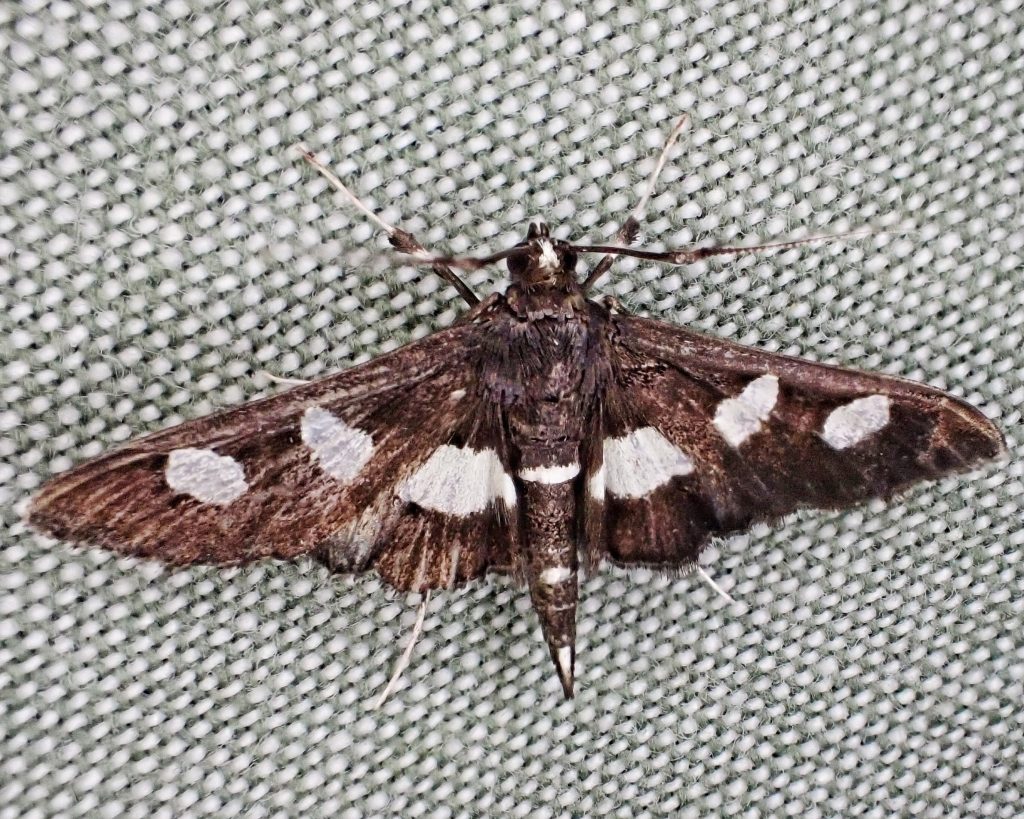
Adults active– Diurnal, though they also occasionally come to lights; may be active from April into October, with peaks in May, July and late August.
Life cycle– David James, in his final report to the Washington grape growers, states that Desmia maculalis “…overwinters as a dormant pupa in a folded leaf or leaf fragment on the vineyard floor. Moths emerge in late April-early May and produce the first larval generation that folds grape leaves in June. These larvae either have prolonged developement (2018) producing moths in August and a second larval generation in September-October, or they produce moths in early-mid July (2019). July moths produce a second generation of larvae in late July-August, that produce a third generation of moths and larvae in September-October. Further research will determine whether it is two or three generations that is predominant across years.” David told me in a personal communication that, after further research, he thinks the number of generations varies with the season. When there are warm early springs there is time for a third generation, and when it’s cold in the spring they only have two generations. Three generation years are hardest on the vineyard, because the number of larvae is much greater.
Etymology of names– Desmia is from the Greek word for ‘chain/bundle/tie/band’, though I cannot ascertain what this refers to. The specific epithet maculalis is from the Latin word for ‘spot/stain/mark’ and presumably refers to the white spots on fore- and hindwing.
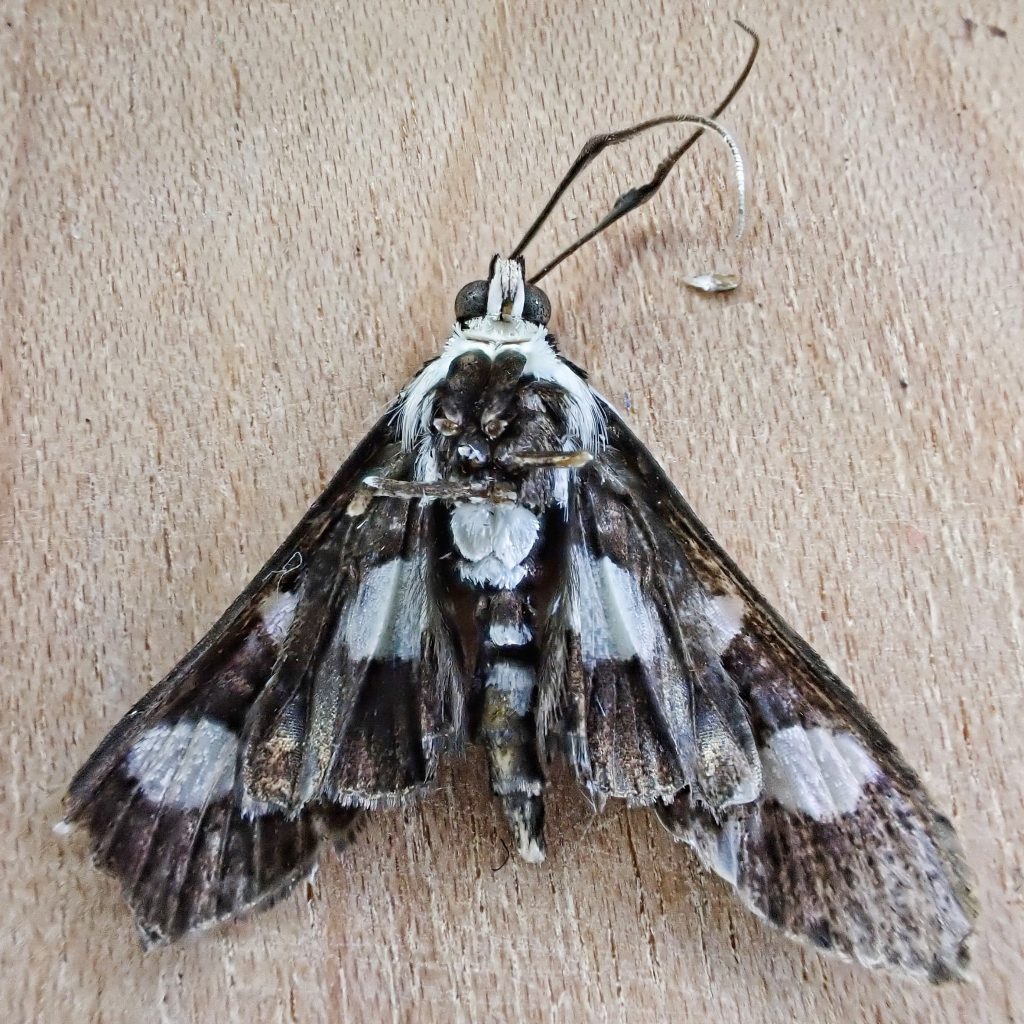
Species Desmia maculalis – Grape Leafroller – Hodges#5160 – BugGuide.Net
Desmia funeralis vs Desmia maculalis – BugGuide.Net
http://mothphotographersgroup.msstate.edu/species.php?hodges=5160
Desmia maculalis Westwood, 1831 | Butterflies and Moths of North America
Desmia maculalis – White-headed Grape Leaffolder | Prairie Haven
https://naldc.nal.usda.gov/download/CAT87211708/pdf
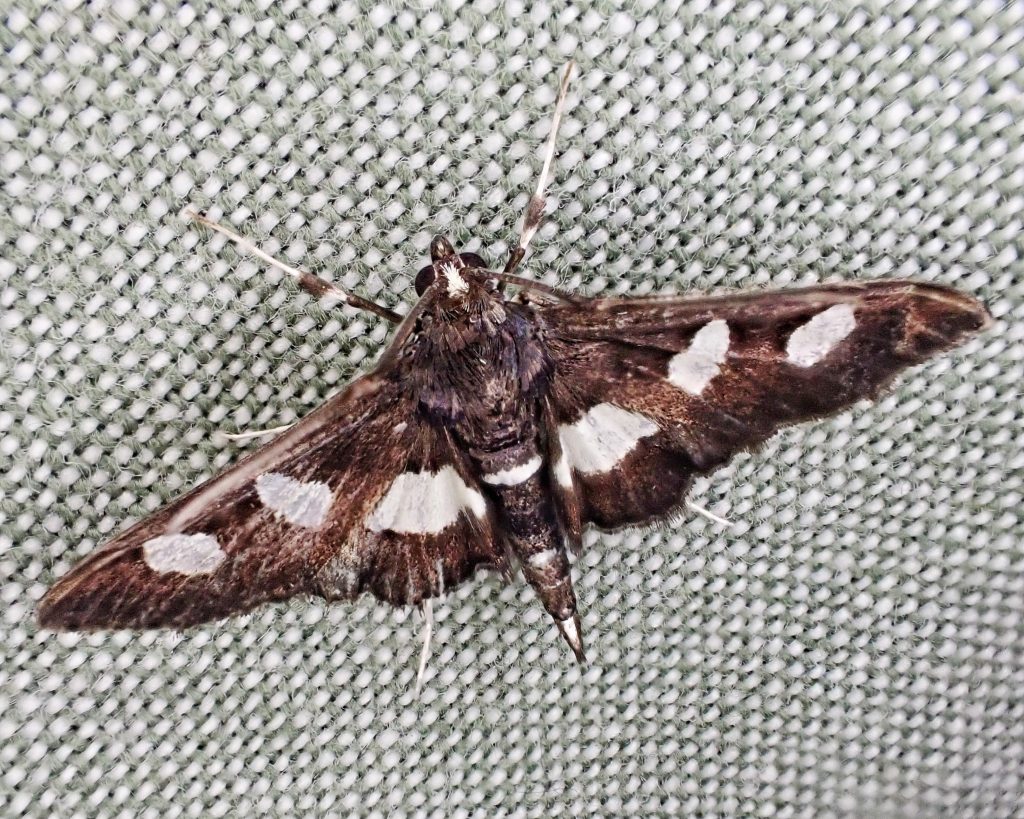
In regards to your statement, “Desmia is from the Greek word for ‘chain/bundle/tie/band’, though I cannot ascertain what this refers to,” perhaps Desmia is used because the larvae bundles or ties a band around the leaf to roll it up?
That seems like a reasonable guess, Jennie! Thanks!